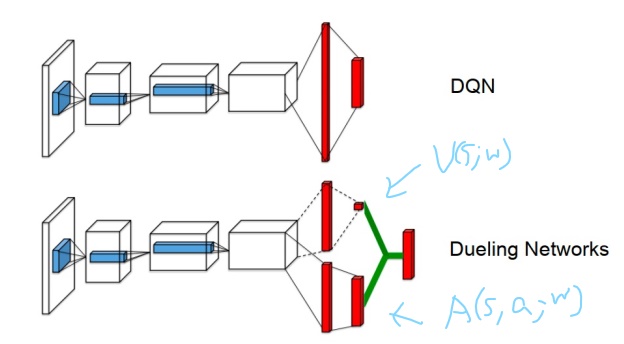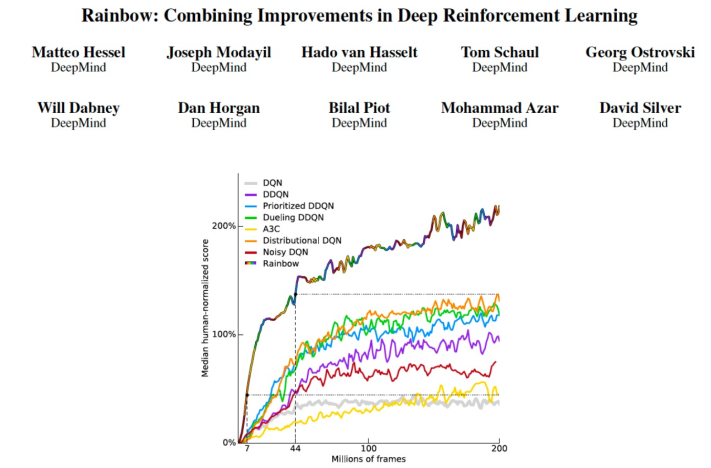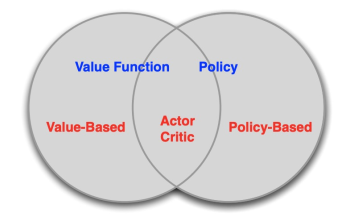Advanced DQN and Policy Gradient
DQN Variants
本节我们先来介绍一下 DQN 的几种 variants。
Double DQN
在加入 Target Network 后,DQN 的 loss function 为:
$$\mathcal{L}(w)=\left(r_t+\gamma\max_{a^{\prime}}Q(s_{t+1}, a^{\prime}; w^-)-Q(s_t, a_t; w)\right)^2$$
在 $Q(s, a; w)$ 收敛的过程中,我们可以将其视为一个随机变量,其值随着 $w$ 的变化而上下浮动,以真值 $\hat{Q}(s,a)$ 为期望。由于采用了 Experience Replay,同一个 transition 会在 $w$ 不同的时候被多次计算,我们实际上在以:
$$\mathbb{E}_{w^-}\left[r_t+\gamma\max_{a^{\prime}}Q(s_{t+1}, a^{\prime}; w^-)\right]$$
为 target 优化 $Q(s_t, a_t; w)$。根据不等式:
$$\mathbb{E}(\max(X_1, X_2, …))\geq \max(\mathbb{E}(X_1), \mathbb{E}(X_2), …)$$
我们能得到:
$$\mathbb{E}_{w^-}\left[r_t+\gamma\max_{a^{\prime}}Q(s_{t+1}, a^{\prime}; w^-)\right]\geq r_t+\gamma \max_{a^{\prime}} \hat{Q}(s_{t+1}, a^{\prime})$$
不等式右边才是我们想要的 target,因此可见 DQN 往往会存在 overestimation 的问题。我们使用的 target 会比实际的 target 大。
解决方法是我们用当前的 $Q$-network $w$ 来选择最好的 action,但用之前的 $Q$-network $w^-$ 来 evaluate action,即:
$$\mathcal{L}(w)=\left(r_t+\gamma Q\left(s_{t+1}, \argmax_{a^{\prime}}Q(s_{t+1}, a^{\prime}; w); w^-\right)-Q(s_t, a_t; w)\right)^2$$
这个方法被称为 Double DQN。
显然,$Q\left(s_{t+1}, \argmax_{a^{\prime}}Q(s_{t+1}, a^{\prime}; w); w^-\right)\leq \max_{a^{\prime}}Q\left(s_{t+1}, a^{\prime}; w^-\right)$。因此相较于 DQN,Double DQN 可以在一定程度上缓解 overestimation 带来的影响。并且当 $w^-$ 和 $w$ 收敛之后,不等式会取等。
Prioritized Experience Replay
由于 DQN 对 replay buffer 里的 samples 学习好坏程度并不相同,有些 samples 学习得较好,有些则学习得较差。如果每次从 buffer 中取 samples 都完全随机的话,有可能会 overfit 到一些 samples 上,而另一些 samples 则几乎没学到。这样就会让训练效果变差,训练速度变慢。
解决方法是每次根据学习得好坏来对 replay buffer 进行加权采样。Store experience in priority queue according to DQN error:
$$\left|r_t+\gamma\max_{a^{\prime}}Q(s_{t+1}, a^{\prime}; w^-)-Q(s_t, a_t; w)\right|$$
对 error 进行一些函数变换之后作为 sample 的权重。这个方法被称作 Prioritized Experience Replay。
Dueling DQN
我们定义 advantage function:
$$A^{\pi}(s,a)=Q^{\pi}(s,a)-V^{\pi}(s)$$
用来衡量 state $s$ 下,action $a$ 相较于其他的 actions 好多少。
Dueling DQN 将 $Q$-network 分为两个 channel,一个 channel 用来学习只与 state 有关的 value function $V(s;w)$;另一个 channel 学习 advantage function $A(s,a;w)$。计算 $Q$ 时将二者加起来:
$$Q(s,a;w)=V(s;w)+A(s,a;w)$$
其中 $V(s;w)$ 与 $A(s,a;w)$ 共享部分结构,如下图所示。网络的输入是 $s$ 的 vector representation,输出是大小为 $|A|$ 的向量。$V(s;w)$ 的输出在图中呈现为单个数。

$n$-Step Return
我们先前一直用的都是 1-step return 作为 target,当然也可以用 $n$-step return:
$$\mathcal{L}(w)=\left(R_t^{n}+\gamma^n\max_{a^{\prime}}Q(s_{t+n}, a^{\prime}; w^-)-Q(s_t, a_t; w)\right)^2$$
Rainbow
Rainbow 这篇工作总结比较了 DQN 的许多变种,并同时运用了这些 tricks 来得到较好的效果。

Policy Gradient
相较于 $Q$-learning,DQN 已经在一定程度上解决了 $|S|$ 与 $|A|$ 较大的问题,但还不够,从 $Q$ function 得到 policy 需要对 $Q(s,a) \forall a$ 进行比较,这相当耗时。为了在更大的空间里进行 RL,我们希望直接参数化 policy:
$$\pi_{\theta}(s,a)=\mathbb{P}[a|s,\theta]$$
Three Types of RL Methods
RL 可以根据是否学习参数化的 value/$Q$ function,是否学习参数化的 policy 分为三大类
- Value Based: Learn Value/$Q$ Function, Implicit Policy.
- Policy Based: No Value Function, Learn Policy.
- Actor-Critic: Learn Value Function, Learn Policy.

我们之前讲的方法都属于 Value Based,这部分会介绍 Policy Based Method,而下一节会讲 Actor-Critic。
Policy Parameterization
先讲如何 parameterize $\pi_{\theta}$。
Softmax Policy
$$\pi_{\theta}(s,a)\propto e^{\phi(s,a)^{\top}\theta}$$
其中 $\phi(s,a)$ 是 $s,a$ 的 features,也可以用 neural networks 表示。
定义 score function 为 $\nabla_{\theta}\log \pi_{\theta}(s,a)$ (后面的推导中会看到为何要这么定义)。那么 softmax policy 的 score function 为:
$$\nabla_{\theta}\log \pi_{\theta}(s,a)=\phi(s,a)-\mathbb{E}_{\pi_{\theta}}[\phi(s,\cdot)]$$
Gaussian Policy
一个更广泛运用的 parameterized policy 是 Gaussian Policy,其只适用于 continuous actions。
Action 的均值为 $\mu(s)=\phi(s)^{\top}\theta$,其中 $\phi(s)$ 是 $s$ 的 features,也可以用 neural networks 表示。
Action 的方差为 $\sigma^2$,可以是固定的,也可以是 parameterized 的。
Action 从高斯分布中采样,$a\sim \mathcal{N}(\mu(s), \sigma^2)$。
Score function:
$$\nabla_{\theta}\log \pi_{\theta}(s,a)=\frac{(a-\mu(s))\phi(s)}{\sigma^2}$$
Policy Objective Functions
既然要学习参数化的 policy $\pi_{\theta}(s,a)$,那么该如何衡量 policy 的好坏,如何定义 objective function to maximize。一种可行的定义方法是 average reward per time-step:
$$J_{avR}(\theta)=\sum_{s}d^{\pi_{\theta}}(s)\sum_a\pi_{\theta}(s,a)r(s,a)$$
这里,$d^{\pi_{\theta}}$ 是 MDP 在 $\pi_{\theta}$ 下的稳定分布。
不过,在 model-free 的情况下我们无法得知 $d^{\pi_{\theta}}$,另一种较为直接的办法就是 maximize expected return of trajectories:
$$J(\theta)=\mathbb{E}_{\tau}[R(\tau)]$$
Gradient of Objective Functions
为了更新 policy,我们需要对 objective funcion 进行 gradient ascent:
$$\Delta \theta = \alpha \nabla_{\theta}J(\theta)$$
接下来就对这个导数进行推导。
$$\begin{align*} \nabla_{\theta}J(\theta)&=\nabla_{\theta}\sum_{\tau}\mathbb{P}(\tau|\theta)R(\tau)\\ &=\sum_{\tau}R(\tau)\nabla_{\theta}\mathbb{P}(\tau|\theta)\\ &=\sum_{\tau}R(\tau)\mathbb{P}(\tau|\theta)\frac{\nabla_{\theta}\mathbb{P}(\tau|\theta)}{\mathbb{P}(\tau|\theta)}\\ &=\sum_{\tau}R(\tau)\mathbb{P}(\tau|\theta)\nabla_{\theta}\log\mathbb{P}(\tau|\theta)\\ &=\mathbb{E}_{\tau}\left[R(\tau)\nabla_{\theta}\log\mathbb{P}(\tau|\theta)\right] \end{align*}$$
假设 $\tau = s_0, a_0, r_0, s_1, a_1, …, s_{T-1}, a_{T-1}, r_{T-1}, s_T$,那么有:
$$\mathbb{P}(\tau|\theta)=\mu(s_0)\prod_{t=0}^{T-1}\left[\pi(a_t|s_t,\theta)\mathbb{P}(s_{t+1},r_t|s_t, a_t)\right]$$
其中 $\mu(s_0)$ 是 initial distribution。取对数:
$$\log\mathbb{P}(\tau|\theta)=\log\mu(s_0)+\sum_{t=0}^{T-1}\left[\log\pi(a_t|s_t,\theta)+\log\mathbb{P}(s_{t+1},r_t|s_t, a_t)\right]$$
求导:
$$\nabla_{\theta}\log\mathbb{P}(\tau|\theta)=\nabla_{\theta}\sum_{t=0}^{T-1}\log\pi(a_t|s_t,\theta)$$
代入原式中,得到:
$$\nabla_{\theta}J(\theta)=\mathbb{E}_{\tau}\left[R(\tau)\nabla_{\theta}\sum_{t=0}^{T-1}\log\pi(a_t|s_t,\theta)\right]$$
在已知 $\tau$ 以及 $\pi$ 的情况下,括号中的内容可以直接算出。Expectation 则可以用 MC 来 estimate。
REINFORCE
根据以上的推导,得出了一个 MC-based, policy-based RL method:
REINFORCE:
- sample {$\tau^i$} from $\pi_{\theta}$ (run the policy)
- $\nabla_{\theta}J(\theta)\approx\frac{1}{|\{\tau^i\}|}\sum_{i}\left[R(\tau_i)\sum_{t}\nabla_{\theta}\log\pi_{\theta}(a_t^i|s_t^i)\right]$
- $\theta\leftarrow \theta+\alpha\nabla_{\theta}J(\theta)$
REINFORCE 的一个问题是,其只能用当前 policy 跑出来的 trajectory 进行策略的更新,即它是 on-policy 的。用别的 policy 跑出来的 trajectory 进行更新会导致 MC estimate 错误。这样一种性质使得 REINFORCE 的训练非常慢。下一节课会讲如何改进得到 off-policy Policy Gradient。
Baseline with REINFORCE
REINFORCE 中采用 MC 的方法进行 estimate,会导致 high variance,我们试图减小 variance。先不考虑整个 trajectory,只考虑一个 step。即减小 $r(s,a)\nabla_{\theta}\log\pi_{\theta}(s,a)$ 的方差。
注意到,$\forall B(s)$ irrelevant with $a$:
$$\begin{align*} \mathbb{E}_{\pi_{\theta}}\left[B(s)\nabla_{\theta}\log\pi_{\theta}(s,a)\right]&=\sum_{a}\pi_{\theta}(s,a)B(s)\nabla_{\theta}\log\pi_{\theta}(s,a)\\ &=\sum_{a}B(s)\nabla_{\theta}\pi_{\theta}(s,a)\\ &=B(s)\nabla_{\theta}\sum_{a}\pi_{\theta}(s,a)\\ &=B(s)\nabla_{\theta}1\\ &=0 \end{align*}$$
故而用 $\mathbb{E}_{\pi_{\theta}}\left[\left(r(s,a)-B(s)\right)\nabla_{\theta}\log\pi_{\theta}(s,a)\right]$ 来代替 $\mathbb{E}_{\pi_{\theta}}\left[r(s,a)\nabla_{\theta}\log\pi_{\theta}(s,a)\right]$ 并不会影响 expectation。并且我们可以证明,当 $B(s)$ 合适的时候,$\text{Var}_{\pi_{\theta}}\left[\left(r(s,a)-B(s)\right)\nabla_{\theta}\log\pi_{\theta}(s,a)\right] < \text{Var}_{\pi_{\theta}}\left[r(s,a)\nabla_{\theta}\log\pi_{\theta}(s,a)\right]$:
$$\begin{align*} &\text{Var}_{\pi_{\theta}}\left[\left(r(s,a)-B(s)\right)\nabla_{\theta}\log\pi_{\theta}(s,a)\right] - \text{Var}_{\pi_{\theta}}\left[r(s,a)\nabla_{\theta}\log\pi_{\theta}(s,a)\right]\\ =&\mathbb{E}_{\pi_{\theta}}\left[\left(r(s,a)-B(s)\right)\nabla_{\theta}\log\pi_{\theta}(s,a)\right]^2 - \mathbb{E}_{\pi_{\theta}}\left[r(s,a)\nabla_{\theta}\log\pi_{\theta}(s,a)\right]^2\\ =&\mathbb{E}_{\pi_{\theta}}\left[\left(B(s)^2-2r(s,a)B(s)\right)\left(\nabla_{\theta}\log\pi_{\theta}(s,a)\right)^2\right]\\ =&B(s)^2\mathbb{E}_{\pi_{\theta}}\left[\nabla_{\theta}\log\pi_{\theta}(s,a)\right]^2-2B(s)\mathbb{E}_{\pi_{\theta}}\left[r(s,a)\left(\nabla_{\theta}\log\pi_{\theta}(s,a)\right)^2\right] \end{align*}$$
这是个二次函数,当 $B(s)=\frac{\mathbb{E}_{\pi_{\theta}}\left[r(s,a)\left(\nabla_{\theta}\log\pi_{\theta}(s,a)\right)^2\right]}{\mathbb{E}_{\pi_{\theta}}\left[\nabla_{\theta}\log\pi_{\theta}(s,a)\right]^2}$ 时,两个 Variance 的差取最小值,小于0。
$B(s)$ 称为 baseline。在 REINFORCE 中,选择一个合适的 constant baseline 也可以 reduce variance:
$$\nabla_{\theta}J(\theta)=\mathbb{E}_{\tau}\left[(R(\tau)-B)\nabla_{\theta}\sum_{t=0}^{T-1}\log\pi(a_t|s_t,\theta)\right]$$